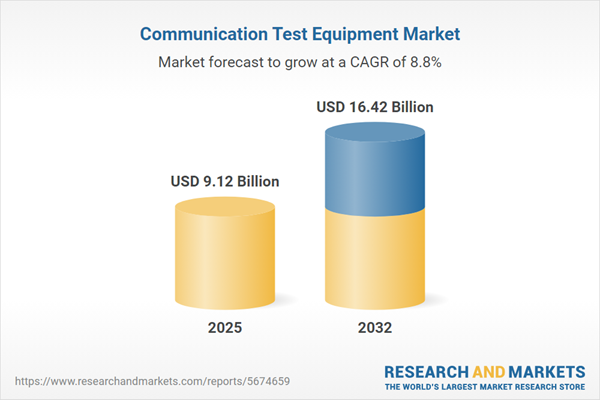Speak directly to the analyst to clarify any post sales queries you may have.
The Communication Test Equipment Market is critical for organizations seeking to secure, maintain, and optimize increasingly complex digital networks. In today’s dynamic environment, robust testing solutions enable senior decision-makers to ensure infrastructure reliability, regulatory compliance, and operational efficiency for both current and future connectivity requirements.
Market Snapshot: Communication Test Equipment Market Overview
The Communication Test Equipment Market is witnessing sustained expansion as organizations across multiple sectors prioritize modernization and adapt to shifting connectivity needs. With a current valuation of USD 8.38 billion and an anticipated CAGR of 8.76%, this sector’s progress is driven by strategic network upgrades and increased emphasis on digital transformation. Advanced wireless and digital platforms are propelling the need for innovative test solutions, particularly in telecommunications, aerospace, defense, automotive, energy, and manufacturing. These industries leverage next-generation testing capabilities to streamline operations, strengthen compliance protocols, and address the complexities emerging within a global, digitally integrated ecosystem. Increasing technology investments reinforce the strategic role of communication test equipment in enabling scalable, efficient, and secure infrastructures.
Scope & Segmentation
- Product Types: Network analyzers, oscilloscopes, signal generators, spectrum analyzers, and vector signal analyzers all play an integral role in validating protocols, ensuring operational reliability, and optimizing device performance within interconnected environments.
- Technologies Covered: Test solutions address existing and emerging standards, including 5G (Fr1, Fr2), Bluetooth (Classic, Low Energy), IoT protocols such as LoRa, LTE-M, NB-IoT, as well as evolving LTE and 4G (FDD/TDD). Wi-Fi solutions range from Wi-Fi 5 through Wi-Fi 6E. Adaptability in wired and wireless testing supports the diverse architectures deployed by organizations globally.
- End User Industries: Precision test tools support seamless and secure operations for aerospace and defense, both civil and military, automotive OEMs and their suppliers, electronics, pharmaceutical manufacturing, energy operators, and telecommunications providers.
- Testing Methods: Core procedures include conformance validation, interference assessment, performance evaluation, reliability analysis, and rigorous security checks, ensuring product alignment with regulatory standards and lifecycle benchmarks.
- Deployment Modes: Solutions are accessible as benchtop, field, automated, laboratory, and portable systems, enabling research, manufacturing, and maintenance teams to address varied operational challenges efficiently.
- Geographic Coverage: The market spans the Americas, Europe, Middle East and Africa, and Asia-Pacific. Regional approaches are shaped by localization needs, regulatory pressures, and unique investment strategies, ensuring alignment with both global and local requirements.
Key Takeaways for Senior Leaders
- Software-defined and virtualized test systems offer greater adaptability, empowering organizations to manage distributed teams and respond proactively to evolving network demands or internal structural changes.
- Cloud-based testing enhances collaborative workflows for geographically distributed teams, resulting in accelerated deployment cycles and efficient, continuous improvement of network infrastructures.
- AI-driven analytics improve detection capabilities, as organizations can anticipate vulnerabilities and address maintenance proactively, supporting operational resilience and strategic risk management.
- Ongoing advancements in wireless and IoT technologies compel investment in flexible, future-ready testing strategies that support existing infrastructure while easing adaptation to new standards.
- Diversifying supply chains supports ongoing innovation and delivers greater resilience against disruptions, ensuring stable access to critical components and consistent performance regardless of fluctuations in sourcing or global conditions.
Tariff Impact on Supply Chain and Innovation
With new US tariffs anticipated in 2025, manufacturers must confront increasing operational and sourcing costs in the Communication Test Equipment Market. To reduce disruption risk, executive teams should explore alternate procurement channels and optimize component selection strategies. Integration of digital twins and advanced simulation technologies streamlines product development cycles, ensuring the pace of innovation continues despite trade uncertainties. For lasting supply chain resilience, organizations are also focusing on regional supplier collaboration and the expansion of local manufacturing capabilities to respond quickly to tariff-induced challenges and sustain business agility.
Methodology & Data Sources
This report is grounded in interviews with senior executives, engineers, and specialists in quality assurance. The analysis is strengthened by a review of technical papers and current regulatory documentation. Rigorous triangulation and peer review assure the reliability and relevance of the strategic insights presented.
Why This Report Matters
- Supports evaluation of system validation approaches, enabling organizations to enhance network efficiency, interoperability, and meet evolving compliance standards at a global scale.
- Offers actionable insights for strategic planning, supply chain management, and risk mitigation, allowing teams to navigate change and respond to unforeseen challenges.
- Delivers competitive analysis and timely market intelligence, guiding technology adoption and process improvement across critical business functions.
Conclusion
This report provides actionable recommendations to help decision-makers strengthen validation practices, adapt effectively to industry changes, and improve operational resilience in the evolving communications sector.
Additional Product Information:
- Purchase of this report includes 1 year online access with quarterly updates.
- This report can be updated on request. Please contact our Customer Experience team using the Ask a Question widget on our website.
Table of Contents
3. Executive Summary
4. Market Overview
7. Cumulative Impact of Artificial Intelligence 2025
List of Figures
Samples

LOADING...
Companies Mentioned
The key companies profiled in this Communication Test Equipment market report include:- Keysight Technologies, Inc.
- Rohde & Schwarz GmbH & Co. KG
- Anritsu Corporation
- National Instruments Corporation
- VIAVI Solutions Inc.
- Tektronix, Inc.
- Spirent Communications plc
- EXFO Inc.
- Advantest Corporation
- Yokogawa Electric Corporation
Table Information
| Report Attribute | Details |
|---|---|
| No. of Pages | 187 |
| Published | October 2025 |
| Forecast Period | 2025 - 2032 |
| Estimated Market Value ( USD | $ 9.12 Billion |
| Forecasted Market Value ( USD | $ 16.42 Billion |
| Compound Annual Growth Rate | 8.7% |
| Regions Covered | Global |
| No. of Companies Mentioned | 11 |









